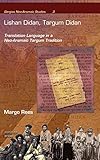Lishan Didan, Targum Didan : Translation Language in a Neo-Aramaic Targum Tradition / Margo Rees.
Material type: TextSeries: Gorgias Neo-Aramaic StudiesPublisher: Piscataway, NJ : Gorgias Press, [2008]Copyright date: ©2008Description: 1 online resource (326 p.)Content type:
TextSeries: Gorgias Neo-Aramaic StudiesPublisher: Piscataway, NJ : Gorgias Press, [2008]Copyright date: ©2008Description: 1 online resource (326 p.)Content type: - 9781593334260
- 9781463211622
- 221.4/3
- online - DeGruyter
| Item type | Current library | Call number | URL | Status | Notes | Barcode | |
|---|---|---|---|---|---|---|---|
 eBook
eBook
|
Biblioteca "Angelicum" Pont. Univ. S.Tommaso d'Aquino Nuvola online | online - DeGruyter (Browse shelf(Opens below)) | Online access | Not for loan (Accesso limitato) | Accesso per gli utenti autorizzati / Access for authorized users | (dgr)9781463211622 |
Browsing Biblioteca "Angelicum" Pont. Univ. S.Tommaso d'Aquino shelves, Shelving location: Nuvola online Close shelf browser (Hides shelf browser)
Frontmatter -- Table of Contents -- Preface -- Acknowledgments -- Abbreviations -- General Introduction -- I. Morphology -- II. Translation Technique -- III. Comparative analyses -- Concluding remarks -- Bibliography -- Appendix: Manuscript Barzani—Sample Pages -- Glossary of Neo-Aramaic from msB
restricted access online access with authorization star
http://purl.org/coar/access_right/c_16ec
This study examines the language and translation technique used in a modern “targum” of the Bible. The targum – referred to as “Manuscript Barzani” – is a written preservation of a tradition of Jewish Neo-Aramaic Bible translation, originally transmitted in oral form among the religious leaders of a community in Iraqi Kurdistan. It represents a literary form of the Neo-Aramaic spoken by the Jews of the Rewanduz/Arbel region. Within their community, the targum was used in the schools to teach the language and text of the Hebrew Bible to the young men.
Mode of access: Internet via World Wide Web.
In English.
Description based on online resource; title from PDF title page (publisher's Web site, viewed 01. Dez 2022)









